
Wuchang is one of 13 urban districts of the prefecture-level city of Wuhan, the capital of Hubei Province, China. It is the oldest of the three cities that merged into modern-day Wuhan, and stood on the right (southeastern) bank of the Yangtze River, opposite the mouth of the Han River. The two other cities, Hanyang and Hankou, were on the left (northwestern) bank, separated from each other by the Han River.
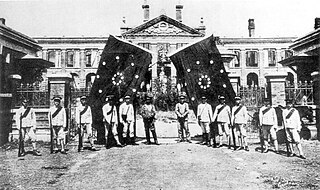
The Wuchang Uprising was an armed rebellion against the ruling Qing dynasty that took place in Wuchang, Hubei, China on 10 October 1911, beginning the Xinhai Revolution that successfully overthrew China's last imperial dynasty. It was led by elements of the New Army, influenced by revolutionary ideas from Tongmenghui. The uprising and the eventual revolution directly led to the downfall of the Qing dynasty with almost three centuries of imperial rule, and the establishment of the Republic of China (ROC), which commemorates the anniversary of the uprising's starting date of 10 October as the National Day of the Republic of China.

The Kowloon–Canton Railway was a railway network in Hong Kong. It was owned and operated by the Kowloon–Canton Railway Corporation (KCRC) until 2007. Rapid transit services, a light rail system, feeder bus routes within Hong Kong, and intercity passenger and freight train services to China on the KCR network, have been operated by the MTR Corporation since 2007.

The Chinese Eastern Railway or CER, is the historical name for a railway system in Northeast China.
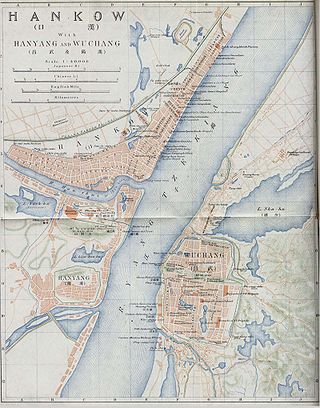
Hankou, alternately romanized as Hankow, was one of the three towns merged to become modern-day Wuhan city, the capital of the Hubei province, China. It stands north of the Han and Yangtze Rivers where the Han flows into the Yangtze. Hankou is connected by bridges to its triplet sister towns Hanyang and Wuchang.

The Benguela Railway is a Cape gauge railway line that runs through Angola from west to east, being the largest and most important railway line in the country. It also connects to Tenke in the Democratic Republic of the Congo (DRC), and to the Cape to Cairo Railway.
In international relations, a concession is a "synallagmatic act by which a State transfers the exercise of rights or functions proper to itself to a foreign private test which, in turn, participates in the performance of public functions and thus gains a privileged position vis-a-vis other private law subjects within the jurisdiction of the State concerned." International concessions are not defined in international law and do not generally fall under it. Rather, they are governed by the municipal law of the conceding state. There may, however, be a law of succession for such concessions, whereby the concession is continued even when the conceding state ceases to exist.

Guangshen railway or Guangzhou–Shenzhen railway, also known as the Chinese section of the Kowloon–Canton railway (廣九鐵路華段) in 1911–1949, is a railway in Guangdong province in the People's Republic of China, between Guangzhou and Shenzhen. It is operated by Guangshen Railway Co., Ltd., a publicly traded company.
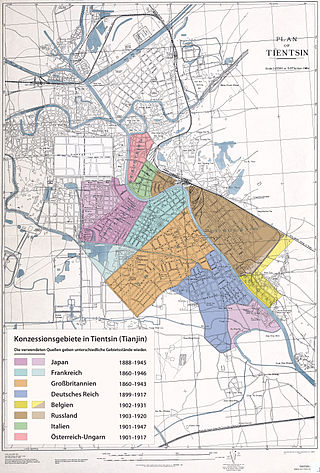
The foreign concessions in Tianjin were concession territories ceded by Qing China to a number of European countries, the United States and Japan within the city of Tianjin. There were altogether nine foreign concessions in old Tianjin on the eve of World War II. These concessions also contributed to the rapid development of Tianjin from the early to mid-20th century. The first foreign concessions in Tianjin were granted in 1860. By 1943, all the foreign concessions, except the Japanese concession, had ceased to exist de facto.

The Beijing–Guangzhou railway or Jingguang railway is a major trunk railway that connects Beijing in the north with Guangzhou in the south. This double-track electrified line has a total length of 2,324 kilometres and spans five provinces through north, central and south China. The line passes through the capitals of each of them: Shijiazhuang (Hebei), Zhengzhou (Henan), Wuhan (Hubei), Changsha (Hunan) and Guangzhou (Guangdong). The line's two terminals are the Beijing West railway station and the Guangzhou railway station.

The Beijing–Hankou or Jinghan railway, also Peking–Hankow railway, was the former name of the railway in China from Beijing to Hankou, on the northern bank of the Yangtze River. The railway was built between 1897 and 1906 by a Belgian company backed by French financing. At Hankou, railway carriages were ferried across the Yangtze River to Wuchang on the southern bank, where they would connect to the Guangdong–Hankou railway. The completion of the Wuhan Yangtze River Bridge in 1957 linked the two railways into a single contiguous railway known as the Beijing–Guangzhou railway.

The Guangzhou–Hankou or Yuehan railway is a former railroad in China which once connected Guangzhou on the Pearl River in the south with Wuchang on the Yangtze River in the north. At the Yangtze, the railway carriages were ferried to Hankou, which then connected to the Beijing–Hankou railway. It was constructed from 1900 to 1936 and, from their former romanizations, was known at the time as the Canton–Hankow railway.
Rail transport in China began in the late nineteenth century during the Qing dynasty. Since then, the Chinese rail network has become one of the largest in the world.
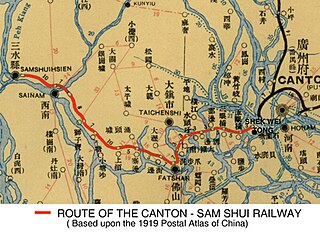
The Guangzhou–Sanshui railway or Guangsan railway, historically known as the Canton–Sam Shui railway, is a railway line in Guangdong province, built from 1902 to 1904. In 2004, the line merged with the Sanshui–Maoming railway to form the Guangzhou–Maoming railway.

Russian Dalian, also known as Kvantunskaya Oblast, was a leased territory ruled by the Russian Empire that existed between its establishment after the Pavlov Agreement in 1898 and its annexation by the Empire of Japan after the Russo-Japanese War in 1905.
Rev. Alfred Alonzo Gilman was an American missionary to Asia. He was born in North Platte, Nebraska, and graduated Phi Beta Kappa from the University of Nebraska in 1898. He was a member of Delta Tau Delta fraternity. He studied for ordination to the priesthood at Philadelphia Divinity School, graduating in 1901. He arrived in China as a missionary in 1902, and was bishop of Missionary District of Hankow in the Chung Hua Sheng Kung Hui. In 1917 he became president of Boone University in Wuchang.

The Railway Protection Movement, also known as the "Railway Rights Protection Movement", was a political protest movement that erupted in 1911 in late Qing China against the Qing government's plan to nationalize local railway development projects and transfer control to foreign banks. The movement, centered in Sichuan province, expressed mass discontent with Qing rule, galvanized anti-Qing groups and contributed to the outbreak of the 1911 Revolution. The mobilization of imperial troops from neighboring Hubei Province to suppress the Railway Protection Movement created the opportunity for revolutionaries in Wuhan to launch the Wuchang Uprising, which triggered the revolution that overthrew the Qing dynasty and established the Republic of China.

The Wuhan–Jiujiang railway or Wujiu railway, is a double-track, electrified railroad in central China between Wuhan in Hubei Province and Jiujiang in Jiangxi Province. The line is 258 km (160 mi) long and follows the south bank of the Yangtze River from Wuchang District in Wuhan to Lushan Station in Jiujiang. Major cities and towns along route include Wuhan, Huarong, Huanggang, Ezhou, Huangshi, Daye Yangxin, Ruichang and Jiujiang.

The Guangzhou–Maoming railway or Guangmao railway, is a railroad in Guangdong Province of China between Guangzhou, the provincial capital, and Maoming. The line has a total length of 404.2 km (251 mi) and comprises the Guangzhou–Sanshui railway, built from 1902 to 1904, and the Sanshui-Maoming railway, built from 1958 to 1991. Major cities and towns along route include Guangzhou, Sanshui, Zhaoqing, Xinxing County, Yangchun, and Maoming.
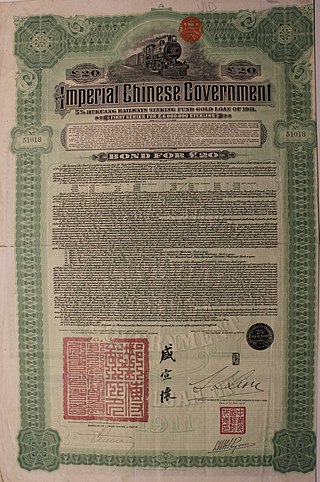
The China Consortium, also referred to as banking consortium or financial consortium or four-, five-, or six-power consortium depending on context, refers to two successive cooperative arrangements formed by foreign banks under their respective governments' directions in the early 20th century, to coordinate lending to the Chinese government. These initiatives were resented by Chinese nationalists and later similarly criticized by Chinese Communists, as instruments of colonialism wielded by Western nations and Japan.

















